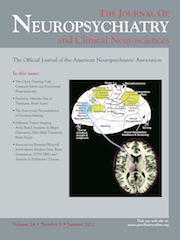Probable Aripiprazole-Induced Tardive Writer's Cramp
To the Editor: Writer's cramp is the most commonly identified tasks-specific focal dystonia of writing, characterized by abnormal muscle spasm of hand and arm.1 We report on a patient in whom writer's cramp developed after 8 months of treatment with aripiprazole. To the best of our knowledge, probable aripiprazole-induced tardive writer's cramp has never been described on the literature that has been reported.
Case Report
Mr. A was a 19-year-old right-handed male high school student with a 4-year history of DSM-IV paranoid schizophrenia. At age 15, he presented with auditory hallucinations, persecutory delusions, delusions of reference, and decreased social interaction. Sulpiride, 400 mg/day, was administered for 2 years, but decreased social interaction and delusions of reference remained. We replaced sulpiride, 400 mg/day, with aripiprazole, 12 mg/day. This switching led to complete remission of his schizophrenic symptoms and he had no adverse event. Afterward he studied hard to take a university entrance examination. Eight months after aripiprazole therapy, he complained that it was hard to write because of a stiffening of his right hand, and these episodes occurred whenever he was willing to write. He showed tight grip of the pen, hyperflexion at wrist joint, flexion at elbow joint, and abduction at shoulder joint when writing. He had no abnormal findings on hematology tests, biochemistry tests, magnetic resonance imaging of the brain, and electroencephalography. He had no other movement disorders except for these symptoms. He also had no family history of dystonia or other movement disorders. His symptoms were diagnosed by neurologists as a writer's cramp. The dosage of aripiprazole was gradually decreased and completely discontinued without recurrence of his psychosis. Despite withdrawal of aripiprazole, he still has these symptoms during 6-month follow up.
Discussion
Our patient had no episode of writer's cramp in the past when he was exposed to the classical antipsychotic sulpiride; nevertheless he developed this movement disorder while on aripiprazole therapy. He had two well known risk factors for dystonia, i.e. being young and male.2 He also fulfilled the criteria for tardive dystonia involving presence of chronic dystonia, history of antipsychotic drug treatment, negative family history for dystonia, and exclusion of known causes of secondary dystonia.3 Moreover, it appears that his writer's cramp developed as a form of tardive dystonia not only because of its late appearance but also due to its characteristic persistence following removal of the offending agent. It was recently reported that the writer's cramp could be caused by atypical neuroleptics like risperidone and olanzapine in young patients.4,5 Since aripiprazole exhibits a pharmacological effect different from that of other atypical antipsychotics and typical antipsychotics, it has been considered to be less likely to cause tardive dystonia than other neuroleptics. However, we suggested that aripiprazole can induce a writer's cramp in young male patient and that it may be very difficult to achieve complete remission. The pathophysiological basis of writer's cramp remains obscure. Therefore, the new neuroleptic should be administered with the same caution as conventional agents.
1 : Task-specific dystonias: a review. Ann N Y Acad Sci 2008; 1142:179–199Crossref, Medline, Google Scholar
2 : Tardive drug-induced extrapyramidal syndromes. Pharmacopsychiatry 2000; 33(Suppl 1):14–33Crossref, Medline, Google Scholar
3 : Tardive dystonia: late-onset and persistent dystonia caused by antipsychotic drugs. Neurology 1982; 32:1335–1346Crossref, Medline, Google Scholar
4 : Probable risperidone-induced tardive "writer's dystonia". Prog Neuropsychopharmacol Biol Psychiatry 2010; 34:721Crossref, Medline, Google Scholar
5 : Writer's cramp induced by olanzapine. J Neurol 2001; 248:422Crossref, Medline, Google Scholar



